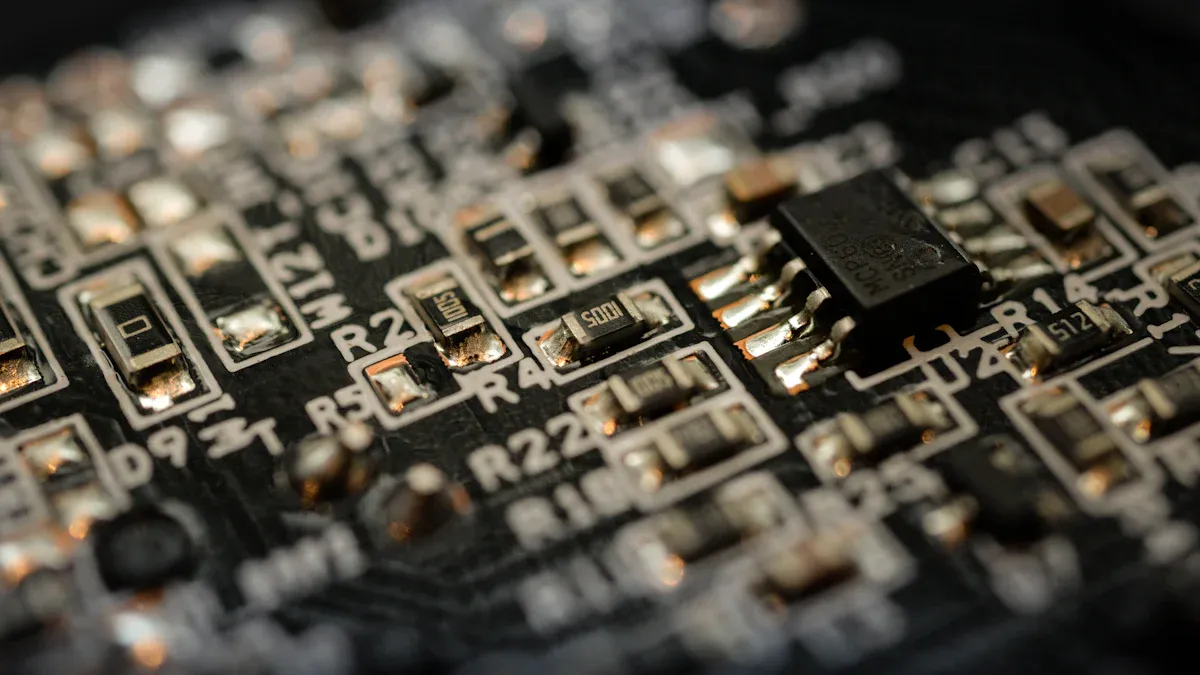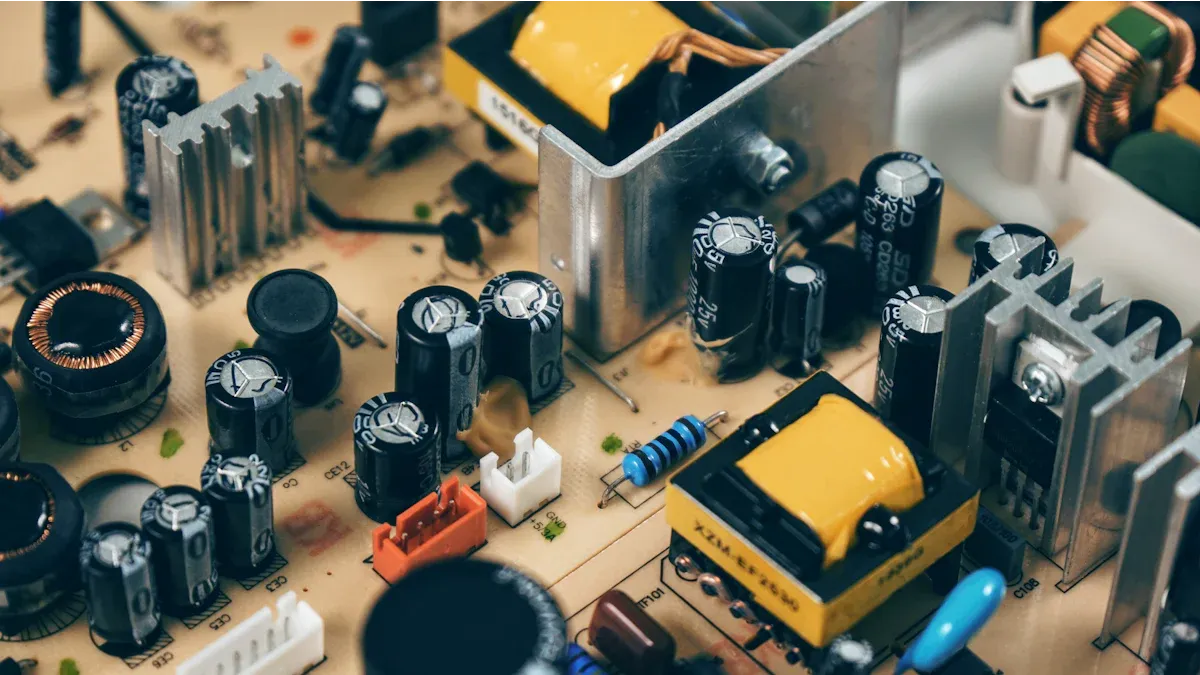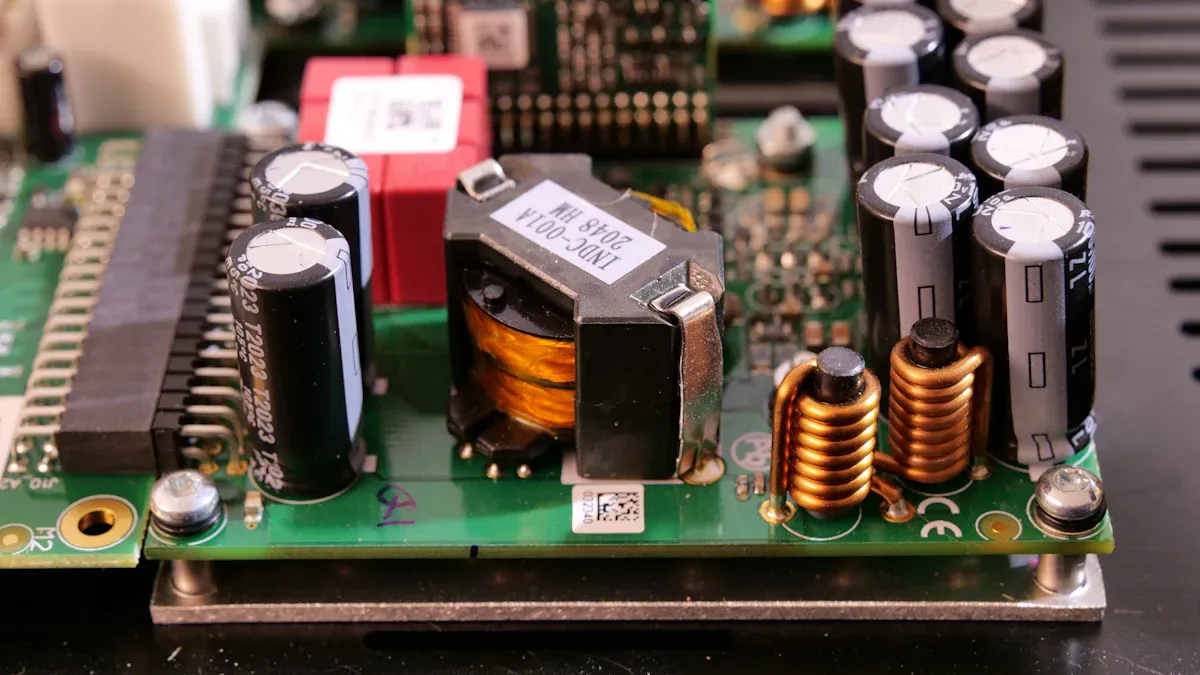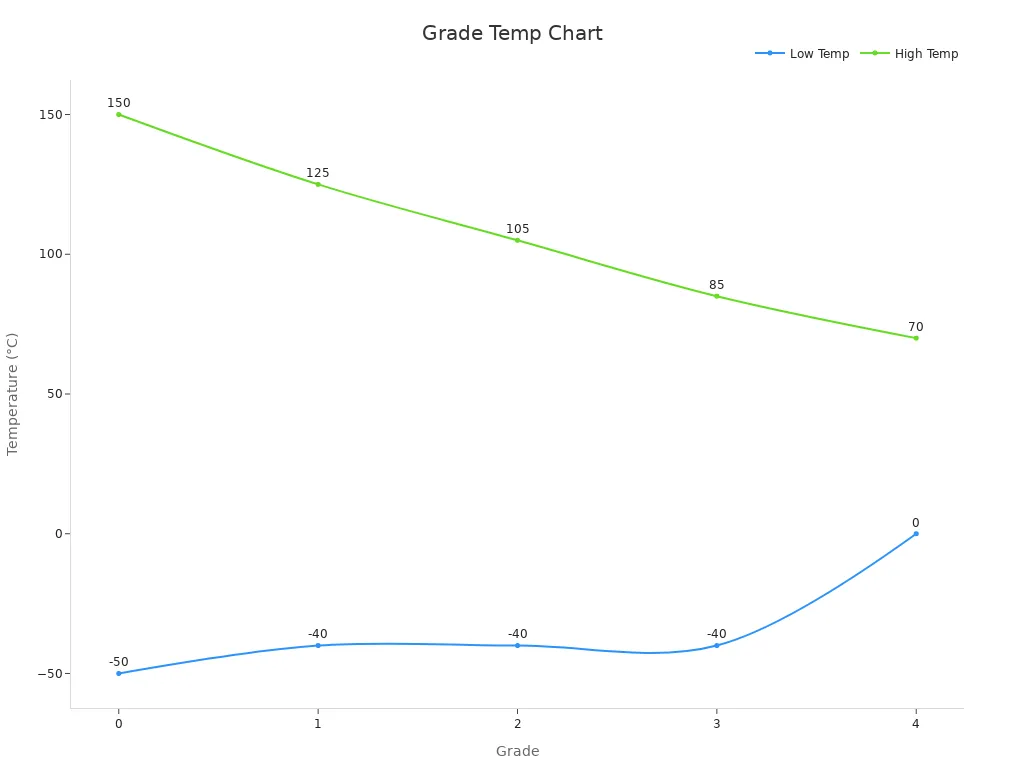
When working with electronics, you encounter two types of parts: active and passive elements. Active elements require external power to function. They enhance or regulate electrical signals, which is crucial for signal processing. In contrast, passive elements do not require external power. They store, release, or manage energy within a circuit.
The primary distinction between active and passive elements lies in their roles. Active elements can amplify or control signals, while passive elements cannot. Understanding this difference enables you to construct and analyze circuits more effectively.
Key Takeaways
Active parts need extra power to work. They increase or control signals, making them important for modern electronics.
Passive parts don’t need extra power. They handle energy by saving, releasing, or using it in a circuit.
Knowing how active and passive parts work helps build better circuits. Each type has a special job to make electronics work well.
Examples of active parts are transistors and diodes. Resistors and capacitors are common passive parts. Both are needed for circuits to work properly.
Using active and passive parts together makes circuits work better and last longer. This teamwork helps devices do hard tasks easily.
Understanding Active Components

Definition of Active Components
Active components are very important in electronics today. They need power from an outside source, like a DC voltage, to work. These parts can boost, switch, or create electrical signals. This makes them key in circuits. Unlike passive parts, active ones add power to a circuit, allowing advanced features. Examples include transistors, diodes, and integrated circuits (ICs).
The history of active components is fascinating. It started with the electron’s discovery in the late 1800s. This led to the invention of electron tubes. Thomas Edison found the Edison effect, later explained by J.J. Thomson and John Ambrose Fleming. This discovery helped create the thermionic valve. This device could change alternating current (AC) into direct current (DC), a big step in early electronics.
Functions of Active Components
Active components have important jobs in circuits. They make weak signals stronger, helping devices like radios and microphones work well. They also turn electrical signals on and off, which is needed in digital circuits. Some active parts create signals, like oscillators that make waveforms for communication systems.
For instance, a transistor can take a small signal and make it bigger. This helps sound systems play louder audio. Integrated circuits combine many active parts to do hard tasks, like processing data in computers or controlling machines.
Examples of Active Components
Active components come in different types, each with special uses. Common examples are:
Transistors: Used to boost signals or switch them on and off.
Diodes: Let current flow one way, often used in rectifiers.
Integrated Circuits (ICs): Combine many parts to do complex tasks.
Optoelectronic Devices: Like LEDs and photodiodes, which work with light.
Active components have become more advanced over time. In the 1960s, a calculator PCB had over 30 transistors. Today, modern motherboards have over a million transistors on one chip. This shows how much technology has improved.
Year | Example Device | Number of Transistors |
|---|---|---|
1960s | Calculator PCB | |
Today | High-density Motherboard | Over 1 million |
These active devices have changed how we use technology. They are a key part of modern electronics.
Exploring Passive Components

Definition of Passive Components
Passive components are very important in electronics. They do not need outside power to work. These parts handle energy by storing, releasing, or moving it in a circuit. They cannot make signals stronger or create them. However, they help keep circuits stable. Examples include resistors, capacitors, inductors, and transformers.
Passive components are grouped by how much heat they can handle. Some can survive very hot places, like engine rooms. Others are made for cooler areas, like passenger spaces. The table below shows these groups:
Grade | Low Temperature | High Temperature | Common Use Areas |
|---|---|---|---|
0 | -50°C | +150°C | All mounting parts |
1 | -40°C | +125°C | Most engine room areas |
2 | -40°C | +105°C | Hot passenger compartments |
3 | -40°C | +85°C | Most passenger compartments |
4 | 0°C | +70°C | Non-electrical equipment spaces |
Functions of Passive Components
Passive components have many important jobs in circuits. They store energy, control voltage, and clean up signals. Capacitors and inductors save energy for later use. Resistors manage current and keep voltage steady. These parts also remove unwanted noise, helping circuits work better.
For example, capacitors stop power changes in supply circuits. Inductors and capacitors improve sound in audio systems. Filters clean signals in communication devices. The table below explains these uses:
Role/Application | Description |
|---|---|
Capacitors and inductors save energy for future use. | |
Filtering | Remove unwanted signals or noise from circuits. |
Voltage Regulation | Resistors manage current and keep voltage steady. |
Real-World Applications | – Power Circuits: Capacitors stop power changes. |
– Audio Systems: Inductors and capacitors improve sound. | |
– Signal Filtering: Filters clean signals in communication systems. |
Examples of Passive Electronic Components
Passive components include resistors, capacitors, inductors, and transformers. Each has a special job in circuits:
Resistors: Control current and keep voltage steady.
Capacitors: Save energy and release it when needed.
Inductors: Store energy in magnetic fields and clean signals.
Transformers: Move energy between circuits and change voltage levels.
These parts are made for specific tasks. For example, Coilcraft’s XEL40xx Series Inductors work well in high-frequency systems. They have low energy loss and help manage power efficiently in modern electronics.

Passive components do not make signals stronger. But they are very important for handling and using energy. Research shows that passive energy devices, like special materials, work well in many conditions. This makes them great for managing energy in circuits and other systems.
Comparing Active and Passive Elements
Power Needs
Active and passive parts use power differently. Active parts need outside power to work. They use this energy to boost signals, make power, or control electricity flow. For example, transistors need power to switch or make signals stronger. Integrated circuits also need power to do hard tasks like running programs.
Passive parts do not need outside power to work. They handle energy already in the circuit by storing, using, or moving it. Resistors manage current without extra power. Capacitors save energy and release it when needed. Inductors store energy in magnetic fields for a short time. These parts work with the circuit’s own power.
Job Differences
Active and passive parts have different jobs in electronics. Active parts do things like boosting signals, switching, and making signals. They make weak signals stronger, which helps radios and microphones work. Transistors, for example, make audio signals louder. Integrated circuits combine active parts to do hard tasks, like running computers.
Passive parts focus on managing energy and cleaning signals. They control voltage, limit current, and remove noise. Capacitors keep power steady for better performance. Inductors and capacitors improve sound in audio systems. Filters clean up signals in communication devices. These parts keep circuits stable and working well.
Examples of Active vs. Passive Parts
Active and passive parts have different uses in circuits. The table below shows their features and examples:
Feature | Passive Parts | Active Parts |
|---|---|---|
Energy Handling | Use, store, or absorb energy; don’t make power. | Make or boost energy; control electricity flow. |
Power Gain | No power gain; gain is less than one. | Provide power gain or make signals stronger. |
Circuit Role | Control voltage, limit current, filter signals. | Boost signals, switch, process data. |
Examples | Resistors, capacitors, inductors, transformers. | Transistors, op-amps, diodes, integrated chips. |
Energy Source | Don’t need outside power to work. | Need outside power to work. |
Control | Fixed settings made during production. | Can change settings with control signals. |
This table shows how active and passive parts work together. Active parts do dynamic tasks, while passive parts manage energy and keep circuits stable. Together, they make modern electronics possible.
Summary Table of Key Differences
When looking at active and passive components, their differences are clear. These differences show how each type helps electronic circuits work. The table below explains the main distinctions:
Aspect | Active Component | Passive Component |
|---|---|---|
Energy Interaction | Adds power or energy to a circuit. | Uses the energy already in the circuit. |
Power Gain | Can increase power, like making signals stronger. | Cannot increase power; only stores or controls energy. |
Role in Circuits | Controls current flow and can boost or create signals. | Handles energy by storing, releasing, or moving it. |
Examples | Diodes, transistors, SCRs, integrated circuits (ICs). | Resistors, capacitors, inductors, transformers. |
Energy Contribution | Gives extra energy to the circuit. | Uses the circuit’s existing energy. |
External Power | Needs power from an outside source to work. | Does not need outside power to function. |
This table shows how active and passive components work together. Active parts do tasks like boosting signals or creating them. Passive parts keep energy steady and manage it in the circuit. Together, they make electronics work well.
Tip: When building circuits, think about what active and passive components do. Knowing their roles will help you design better and more reliable systems.
How Active and Passive Components Work Together
Role of Active Components in Circuits
Active components have important jobs in circuits. They make signals stronger, switch them, or create new ones. Examples include transistors and integrated circuits (ICs). These parts add energy to circuits, helping devices work better. For instance, transistors boost weak signals so radios and microphones can work well. ICs combine many active parts to handle hard tasks like running computers or controlling machines.
In circuits, active components help with signal processing. A transistor has three parts: base, collector, and emitter. These let it boost current or switch signals easily. Diodes are another example. They make sure current flows in only one direction. Active components are key for keeping signals clear and making electronics fast.
Tip: Use simulation tools to learn about active components. These tools show how they boost and control signals in real circuits.
Role of Passive Components in Circuits
Passive components handle energy in circuits by storing, releasing, or using it. They do not need outside power to work. Examples include resistors, capacitors, and inductors. Resistors control current and keep voltage steady. Capacitors save energy and release it when needed. Inductors store energy in magnetic fields.
These parts also clean signals and manage energy. Capacitors and inductors work together in filters to remove noise. This helps communication devices and audio systems give clear outputs. Transformers are another passive part. They move energy between circuits and change voltage levels, which is important for power systems.
A study shows that lowering resistance in passive parts makes them work better. This improves how circuits perform. Passive components are very important for keeping circuits stable and reliable.
Examples of Circuits Combining Active and Passive Components
Circuits often use both active and passive parts to work well. For example, in active RC filters, operational amplifiers (active parts) work with resistors and capacitors (passive parts). Simulations show how changes in passive parts affect the filter’s performance. This shows why both types of parts are important.
Different industries use active and passive parts together to improve devices:
Industry | Performance Improvements | |
|---|---|---|
Telecommunications | Signal processing, enhancing clarity | Reduces noise, improves signal quality |
Automotive | Advanced driver-assistance systems (ADAS) | Enhances performance and reliability |
Aerospace | Flight control systems, avionics | High reliability under extreme conditions |
Medical | Imaging devices, portable diagnostic tools | Ensures precision and durability for diagnostics |
Consumer Electronics | High-end audio equipment, home automation | Enhances user experience through superior performance |
For example, in telecommunications, active parts boost signals while passive parts remove noise. This makes communication clear and reliable. In audio systems, capacitors and inductors improve sound, while transistors make the sound louder.
By using both active and passive parts, circuits become efficient and reliable. This teamwork allows modern devices to perform advanced tasks smoothly.
Active and passive parts have different but important jobs in circuits. Active parts, like transistors and diodes, make signals stronger or control them. Passive parts, such as resistors and capacitors, handle energy and keep circuits steady. Together, they help circuits work well and reliably.
Knowing how they work together helps in building better circuits. Active parts add flexibility and improve performance. Passive parts keep things simple and dependable. The table below shows how these parts team up to make circuits better:
Aspect | Active Parts | Passive Parts |
|---|---|---|
Performance | Boosts flexibility and performance | Keeps circuits simple and steady |
Choosing Components | High-performance parts, may need trade-offs | Balances cost and availability |
Circuit Control | Adjusts for specific frequency needs | Limited control over frequency changes |
Noise Effects | Can cause flicker or voltage noise | Adds thermal or shot noise |
Trade-offs | Flexible but might add noise | Simple but less useful for low frequencies |
Design Difficulty | Harder with more filters | Easier but less control over performance |
Design Tools | Uses SPICE and advanced tools | Relies on basic analysis tools |
Using both active and passive parts lets you build circuits that are advanced and stable. This knowledge helps you design smart and efficient electronic systems.
FAQ
1. What is the main difference between active and passive components?
Active components boost or control signals and need outside power. Passive components handle energy by storing, releasing, or using it without extra power. This difference shows their roles in circuits.
Tip: Active components add energy to circuits. Passive components use the energy already there.
2. Can a circuit work without active components?
Yes, circuits can work with only passive parts, but they are limited. Passive-only circuits cannot boost signals or do hard tasks like data processing. They mostly manage energy and clean signals.
3. Why do active components need external power?
Active components need outside power to do their jobs, like boosting signals or switching currents. This power lets them add energy to circuits, making them important for advanced electronics.
4. How do passive components improve circuit performance?
Passive components help circuits by controlling energy flow. They keep voltage steady, clean signals, and save energy for later. For example, capacitors stop power changes, and inductors improve sound quality.
5. What are some common examples of active and passive components?
Active components include transistors, diodes, and integrated circuits. Passive components include resistors, capacitors, inductors, and transformers. Both types help circuits work well.
Note: Using both active and passive parts makes circuits balanced and efficient.
See Also
Essential PCBA Components And Their Important Roles
Uncovering The Key Distinctions Between PCBA And PCB
Investigating Testing Methods For PCBA In Electronics Production
Understanding The Functional And Structural Variances Of PCBA And PCB